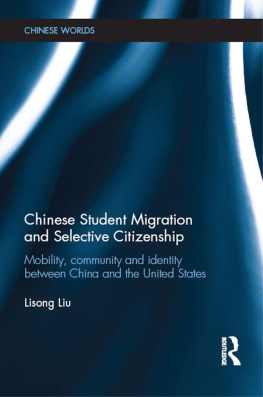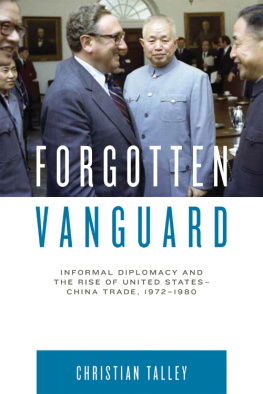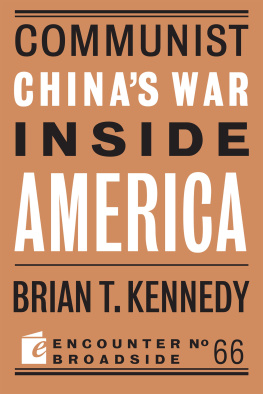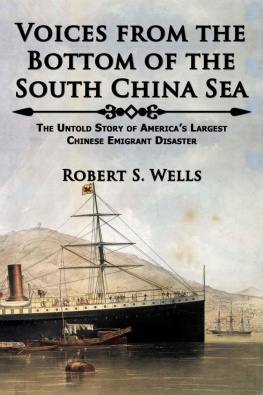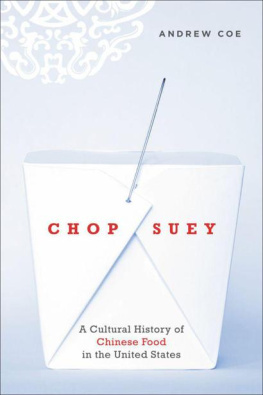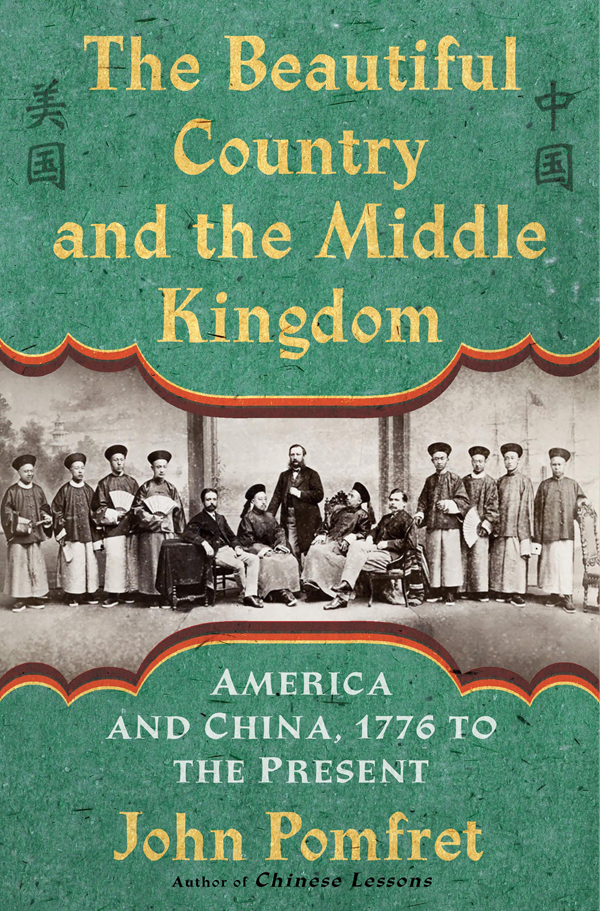Contents
Guide

The author and publisher have provided this e-book to you for your personal use only. You may not make this e-book publicly available in any way. Copyright infringement is against the law. If you believe the copy of this e-book you are reading infringes on the authors copyright, please notify the publisher at: us.macmillanusa.com/piracy.
To Zhang Mei, who pulled me over the finish line
Many people and institutions assisted me in writing this book, providing inspiration, places to stay, funds, and guidance. The Smith Richardson Foundation and the Fulbright Scholar Program awarded me research grants. The Council on Foreign Relations gave me a perch in Washington, DC, in 2011, and Peking University welcomed me as a visiting scholar in 20132014.
At Henry Holt, my editor, Serena Jones, inherited this orphaned project and treated it like her own. I owe her and Holts editor in chief, Gillian Blake, enormous thanks for their patience and guidance. My agent, Gail Ross, as always, provided me with invaluable support.
Thanks go to Peter Fuhrman, who helped me hatch the idea in the first place and provided advice throughout the process. Margaret Johnson and Ray Ottenberg gave me unstinting friendship and a home away from home in Washington, DC; Margaret also expertly pulled together the images for the book. Ray arranged for his book club to read an early version and thanks go to John Claringbould, Fred Hart, John Despres, Bert Rein, Tom Reston, and John Wyss.
At the Washington Post , I benefited from the help of great colleagues past and present: Phil Bennett, Steve Coll, Len Downie, David Hoffman, and Bob Kaiser, along with former CEO Don Graham, were all very supportive of my interest in China. Without them, I would never have made it back there as a correspondent, and thus this book could not have been completed. Marcus Brauchli, Karen Deyoung, Ed Cody, Jon Randal, Rajiv Chandrasekaran, Cameron Barr, Scott Wilson, Keith Richburg, Kevin Sullivan, Jackson Diehl, and Fred Hiatt were all helpful in pushing me to think more deeply about US-China relations. At the New York Times , Joe Kahn and Phil Pan were particularly supportive of this endeavor. Gady Epstein and Evan Osnos, at respectively the Economist and the New Yorker , were so as well. Michael Green, Victor Cha, and Bonnie Glaser, at the Center for Strategic and International Studies, provided invaluable perspective on Americas role in Asia. Michael was also extremely forthcoming in sharing a draft of his wonderful book on the US in Asia. At the Brookings Institution, Li Cheng, Jeffrey Bader, Kenneth Lieberthal, and Dennis Wilder were helpful. At the Council on Foreign Relations, Elizabeth Economy has always been supportive. William Kirby at Harvard and Lydia Liu at Columbia and Charles Hayford provided assistance, as did Chen Jian of Cornell. Michael, Cosimo, and Debbie Thawleys advice and encouragement were invaluable as were those of Orville Schell and Michael Oren. As always, Jim Mann was an excellent sounding board for my numerous odd theories. And thanks go to Paul French for providing key data and great stories on the Yanks in old Shanghai.
Thanks go to the staff at the Asia reading room of the Library of Congress, the American Baptist Historical Society, the George C. Marshall Foundation, and the Hoover Institution on War, Revolution and Peace, particularly Hsiao-ting Lin. In Taiwan, thanks go to Chi Hsi-sheng and also the archives of the Foreign Ministry of the Republic of China.
In China, I benefited from the assistance of many historians and journalists, some of whom cannot be named due to ongoing repression of free speech there. Those who can be named include Shen Zhihua, Yang Kuisong, and Feng Youcai at East China Normal University; Yu Tiejun, Fan Shimin, and Wang Jisi at Peking University; and He Hui at Huanan Normal University. My researcher, Yang Lin, was extremely adept at finding obscure periodicals and documents. Russell Leigh Moses at the Beijing Center opened up its library to me. Special thanks go to Holli Semetko and Emory Universitys Robert W. Woodruff Library for facilitating my research.
I was aided greatly by the assistance of colleagues and friends who read portions of the manuscript. Ed Gargan and Zofia Smardz suffered through numerous drafts. Historians Maochun Yu and Frederic D. Grant Jr. caught key errors. Dick Butterfield hectored me to give it more voice. Steve and Claire Mufson and M. T. Connolly saved me from embarrassing myself. My father, John D. Pomfret, covered an early version in red pencil. My sister, Dana Pomfret, added her keen eye. In the end, of course, I am responsible for all mistakes and infelicities.
At home, my children, Dali, Liya, and Sophie, generally tolerated their increasingly grizzled dad pounding away at the keyboard night and day. In the spring of 2016 as the project entered the home stretch, my mother, Margaret H. Pomfret, passed away. I deeply regret that she never saw it finished. My wife, Zhang Mei, to whom this book is dedicated, supported me throughout this venture, even through its darkest hours. Neither of us can believe that it actually got done.
On a barren landmass nine thousand miles from his native Boston, William Dane Phelps stalked his prey. A colony of elephant seals lazed on a narrow beach, safe from the sharks and orcas that fed on them in the open sea. But here came Phelps, a teenager with a spear. Ten people were waiting to eat, and Phelps had been commanded to cook. The only problem: the meatall nineteen hundred pounds of itwas alive. I was left alone to get breakfast, Phelps recalled. I knew nothing of the habits of the elephant, had never seen one killed, and there I was.
Phelps picked what looked to be the most docile of the beasts and leapt into battle. He struck the seal on the nose. The animal reared up on its flippers, bellowing as it towered over the boy. That opened up the monsters midsection. Phelps tried to plunge in his spear, but the animal caught the weapon in its mouth and gave it a jerk, cracking Phelps on the head and knocking him on his back. Phelps righted himself, bashed out the creatures eyes with his club, and, he wrote, lanced him until he was dead.
It was 1817, and fifteen-year-old Phelps was a six-month sail from home, having just landed on Marion Island, a speck of land one thousand miles from the southernmost tip of Africa. Phelps was one of a crew of twenty-five aboard the Pickering , a brig from Boston that was scouring the seas for fur seals. They had struck pay dirt on Marion. While their ship went off in search of more treasure, Phelps and seven others remained on the windswept isle to hunt and skin.
Phelps and his shipmates spent almost two years on Marion, living in a cave and clothing themselves in animal skins as they killed thousands of fur seals and amassed tons of elephant seal oil. But the mens bounty was not destined for the coats, mufflers, and night lamps of the moneyed families of Beacon Hill and Back Bay. When the Pickering returned for the hunters, it whisked them off not to New Englandbut to Canton, China.
In the early nineteenth century, the promise of the China market sent Americans journeying around the world, killing and harvesting in staggering numbers: six million fur seals; the pelts of a quarter million sea otters; tons of sea cucumber and ginseng; forests of sandalwood; millions of silver dollars, all destined for China. Phelps and hundreds of other Americans spun the first threads of an enormous tapestry that they and their Chinese friends, competitors, customers, lovers, and enemies would weave into a story of wild exploits, extreme misjudgments, and unsung impact.


